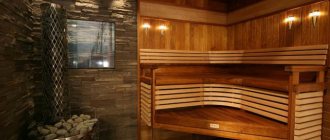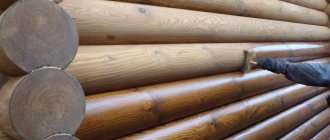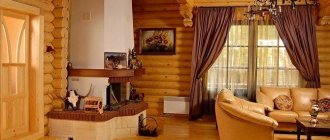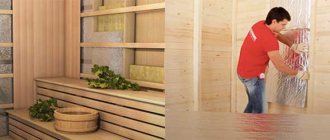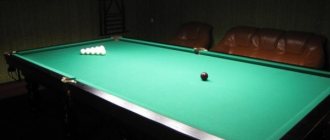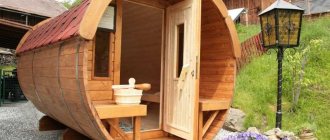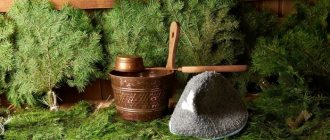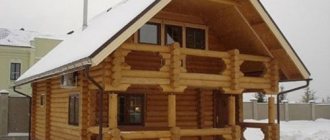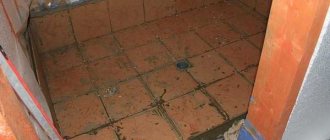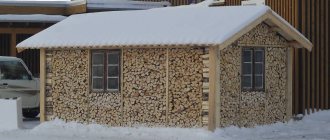Bath impregnations come in two types: water-repellent And antiseptic. They can be combined, but more often they go separately. Therefore, we will consider each type on its own.
Types of bath antiseptics by purpose
First you need to find out what threats to the tree may arise during its construction operation. It can rot and be attacked by insects and rodents. This limits possible harm from wildlife. Of course, wood can also burn, but here we will not touch on protecting it from fire.
Let's start with rotting. The tree itself consists of compounds that would be very difficult to decompose on their own. Therefore, nature helps forests by providing saprophytic organisms. These are fungi and bacteria that process dead wood. In addition, there are fungi that can settle on living trees - these are xylotrophs.
Rotting is the process of destruction of wood by fungi (and, partly, bacteria). But there are fungi that do not destroy wood, but are harmful to humans - these are molds. The third, least harmful type of fungi associated with wood are staining fungi, such as blue fungi.
IMPORTANT! Antiseptics that fight fungi are called fungicides. But we have listed three varieties of harmful mushrooms. And there is no fungicide that is universal against them all. Moreover, even in a separate category, a fungicide substance may be powerless against something. Complex formulations work best. It is better to check their purpose with the seller or even the manufacturer.
Antiseptics for baths intended to combat wood-boring insects are usually specially labeled, for example, “Anti-Bug.” The correct name for such antiseptics is insecticides.
Well, it’s unlikely that poisons for rats and other rodents should be called “antiseptics”; they are classified in a separate category.
The next important distinction must be made regarding the time of use of antiseptics - whether this is done preventively (preventatively), for prophylactic purposes, or when the pest has already actively manifested itself.
From our point of view, the preventive There is little information about what actually happens. Universal compounds have not yet been invented (more precisely, those that really kill everything are extremely harmful for humans too), and the rest have specifics that there is simply nowhere to find out about. The composition is rarely written on the label. We only met him on very expensive products.
Antiseptic 2.7 l. Saunasuoya soup for protection against moisture and dirt. Banka Photos
Often, preventive wood protection products are included in paint and varnish coatings, in particular primers for glazes and other coatings. This looks like a reasonable measure, but for some reason no one specifies what types of fungi this or that antiseptic fights.
It is not possible to correct this situation. We were able to more or less reliably find out the compositions and areas of application for antiseptic fungicides used as industrial impregnations - we are talking about the so-called “impregnated wood”. In this article you will find a list of the classes of substances and who they are most effective against.
But don’t be fooled – on the impregnated wood market you will only find “Tanalit” and “Senezh”, and in exceptional cases something else.
As for preventive antiseptics for self-application, there is no clarity here. All that remains is to rely on the manufacturer, whose task was to provide protection against the most common types of fungi.
In this sense, we never cease to be surprised that on any jar of antiseptic you can read that its contents have an antimicrobial effect. Here the manufacturer himself is confusing something - we humans are afraid of germs. And wood needs protection from fungi. And ordinary bleach, ethyl alcohol, and hydrogen peroxide are quite capable of killing microbes that are harmful to us. Well, you can hang a bactericidal lamp if you really want to get rid of them. But what do wood processing products have to do with it???
IMPORTANT! In general, it is necessary to oblige manufacturers to write the composition and write against what kind of living creatures this composition works. Because now you are buying something unknown and with an unpredictable effect.
Those antiseptics that are designed to combat an already manifested pest are much more precise in their action. If you need to get rid of blue stains, they will sell you bleach. If it is for mold , use some preparation based on boron compounds. If from rot... We suspect that most likely they will sell you some kind of metal-azole complex, and the metal there will be copper. It’s just that triazoles and metal-azole complexes are most common; they are effective, but not against all types of rot.
If you think about it, a possible solution for prevention is to buy antiseptics to combat an already manifested problem, and apply them in advance. At least you will be sure that you did not waste your money and time.
BY THE WAY! For those who are interested in what they are dealing with, we recommend the book “Wood Rot, Its Causes and Control Measures.” Develop, an informed buyer will eventually force the market to take greater responsibility for products!
It should also be mentioned that antiseptics for a sauna or bath will be divided into internal and external, as well as water-soluble and organic-based (insoluble in water). But more on this below.
Antiseptics
Antiseptics are poisons that kill pests. Pests can include bacteria, fungi, algae, mosses, beetles and rodents. The proper name is correct only against the first ones. All others are biocides. Against fungi - fungicides, against insects - insecticides.
There is a lot of wood in the bathhouse, and the most common threat to it is rot. This is a form of wood destruction by certain types of fungi. Therefore, antiseptic fungicides are most often used for preventive and therapeutic purposes. In addition to causing rot, fungi can be moldy and wood staining (for example, blue stain). They require different compounds than rot, but they can be complex.
Fungal infection is blue, it requires impregnation of the bathhouse with an antiseptic.
Antiseptics can be purchased in the form of primers under paintwork materials, or as an independent product. They are also divided into those intended for internal and external work. According to the type of solvent, there are water-soluble and organic solvents .
It is better to use antiseptic impregnation for wood in a bath with caution, especially in a steam room. Follow the link to read an article in which we talk in detail about the use of antiseptics inside and outside the bathhouse.
How to antisepticize outside
For external protection , you can use the strongest means without worrying that they may affect your health. Firstly, if they are certified, then they meet modern requirements for the hazard class for people, and they have become significantly stricter since the beginning of the century. Secondly, external use in any case reduces contact with the evaporating (everything evaporates, just at different rates) antiseptic.
So, an antiseptic for a bath outside can be either industrially applied or independently. Water-soluble or organic-based (i.e., washable or non-washable). As part of the soil or independently.
Prosept Eco Ultra antiseptic is non-washable. Photo City of Masters
The use of such a composition outside is limited to the façade and structural details.
What to give preference to? Industrial processing is deeper than self-processing, so it is better to choose an antiseptic for a bath, which is pumped into wood under high pressure in an autoclave.
If this is not possible, then apply it yourself, choosing non-washable compounds for the facade and hidden parts (joists, beams, etc.) - oil-based, organic solvent-based. After application, do not forget to cover it all with a protective layer of varnish or paint.
ADVICE! Even those who have chosen impregnated wood should cover it with a layer of varnish, preferably with a UV filter - this will protect the wood from environmental influences (not only fungi spoil the wood, but also water freezing in the pores, tearing it apart).
Even more details about all types of coatings used in bathhouses outside can be found here.
Protecting wood from moisture and rotting
In general, first of all, you need to understand the mechanism of wood rotting itself. Everything here seems to be simple, but it turns out that most people are not entirely familiar with it.
Wood itself is a very durable material. And trees dying in the forest could lie there for centuries and millennia (judging by the preservation of individual wooden objects that archaeologists find in dry places), but nature provides for them to be destroyed under the influence of fungi.
In turn, mushrooms need not only wood to grow and develop, but also water and fresh air. Therefore, they do not settle on dry wood. And they cannot be found under water (the tree is perfectly preserved if completely immersed in water). It follows from this that if you block moisture from accessing the inside of a tree, fungi will not multiply in it.
BY THE WAY! It is impossible to completely destroy mushrooms - their spores are constantly floating in the air we breathe. Therefore, the question is always how to make the conditions for the germination of these spores unfavorable.
Unfavorable conditions include wood that is well dried after bathing procedures, as well as water-repellent impregnations. But you can play it safe and apply another layer of antiseptic under the layer of oil - a substance that makes the wood tasteless or poisonous to fungi.
This article describes in detail which impregnations for wood in baths and saunas help cope with both moisture and rot.
How to antisepticize inside
The antiseptic for wood in the bathhouse inside differs from the outside only in less aggressiveness. The substances themselves will be the same, but they will be dissolved in water and therefore fundamentally washed out. The latter means the need for periodic updating.
Treating the bathhouse with an antiseptic inside can be done freely in all rooms except the steam room. Only in a steam room can high temperature affect the retention of the product in the thickness of the wood - most likely the antiseptic will evaporate, getting into the lungs of the steamers.
You can find more information about interior coatings at this link.
Which is better for floors, ceilings, walls
Wherever wood is used, in principle, it would be worth using an antiseptic. Fungal spores are constantly floating in the air, they are just waiting for the right conditions to germinate. Our task is not to create such conditions for them. Including making the wood inedible or at least simply tasteless to them.
What is the difference between an antiseptic for the floor in a bathhouse, for its walls and ceiling? In principle, except that the floor of all of the above will be the coldest and most distant from our respiratory organs.
You need to understand that it is the increase in temperature that makes volatile substances volatile - look in the refrigerator, cold borscht smells much weaker than heated one, because the smell comes from heated and separated particles. It’s the same with an antiseptic - where it’s colder, you can worry less about evaporation.
Antiseptic Zelest A-3 Standard 10 kg, suitable for interior and exterior work. Photo Pilomaterialy.rf
Well, the floor is, after all, a place that suffers more from water in a bathhouse than the same ceiling. Therefore, it needs somewhat more protection.
What do you recommend? We have already said that the best wood is that which has been antisepticized industrially. But this is best used for beams and joists, as well as for subfloors. To clean the floor, you can treat the inside of the bathhouse with an antiseptic, which is included in the primer for varnish or paint.
ATTENTION! You can forget the rule regarding the floor in the steam room, because it is quite normal practice for the floors to be covered with the same yacht varnish, which is not afraid of frequent interaction with water. Before coating with this varnish, you can use an antiseptic, which is intended for the inside of a bathhouse.
However, you can get a complete picture of acceptable floor coverings from this article on our website. And here is material for those who are interested in learning more about floorboards.
The walls and ceiling can be treated in the same way, but avoiding the steam room. Still, do not forget that the antiseptic layer anywhere is intermediate between wood and varnish/paint. At the very least, it is highly desirable that it be intermediate.
Read about how to treat boards used for interior cladding here.
Water repellent
Let's start with the class of impregnations that are made on the basis of hydrophobic substances. They are intended for wood, because it is wood that suffers the most from water, swelling, increasing in size when wet and shrinking again when drying, with the simultaneous formation of cracks.
These are only the problems against which water-repellent bath impregnations are aimed. In addition, there are related problems, also related to water, which antiseptics combat.
IMPORTANT! Usually a person assumes that impregnation for a bath from moisture will make the wood completely unable to absorb it. In fact, it will only reduce the volume of absorption several times, but, of course, it will not be able to completely block it.
Wood oil
One time-honored recipe for extending the life of wood exposed to water is to apply a coat of oil to its surface.
ATTENTION! Not every oil is suitable for such purposes. There is drying and non-drying. To impregnate wood in a bath, the oil must be dry.
Actually, linseed oil is the most common, most optimal option among natural vegetable oils, which are among the drying ones. Therefore, it has been used for a very long time to protect wood.
One of the developments that improves the properties of linseed oil is drying oil - once it was just boiled linseed oil, which dries faster than raw, then they began to add substances to it that accelerate drying even more - these are driers. At the moment, linseed oil makes up only part of natural drying oil.
We do not recommend using drying oil in a bathhouse, especially in a steam room - there it will not only smell for a long time, but also release far from harmless substances into the air. In other rooms, of course, according to desire or necessity, but still in our time there are other means of protecting wood.
So, flaxseed oil (raw or cooked), which can be bought in a supermarket or pharmacy, remains number 1 among oils for impregnating a bath. It can be applied to any wooden surface, except the floor.
Why shouldn't you apply oil to the floor ? Firstly, because such a coating will not be durable . It wears out easily, and when you walk on the floor, you inevitably wear off its top layer. Secondly, such a floor will become slippery for wet feet. Ready-made compositions for bath floors should indicate that they will not slip.
All other surfaces can be coated with linseed oil. Moreover, this applies not only to the interior, but also to the exterior. The facade is also exposed to atmospheric moisture. Impregnating it with oil is a way to protect not only from water, but from other factors leading to cracking. Practice shows that wood that is impregnated with oil becomes more elastic and cracks to a much lesser extent when its dimensions change under the influence of the environment.
In addition to linseed oil, you can find paraffin oil on sale . Judging by the name, it is made from the heavy fraction of oil, but this should not confuse us, because paraffin is widely used in everyday life and even in medicine (in physiotherapy).
Oils that are found on sale are water-soluble - this is also no reason to doubt. Most likely, this is an emulsion with the addition of various stabilizers to facilitate the application and absorption of the composition into the wood.
Impregnation of the bath with linseed oil
Whatever option you choose - store-bought or homemade - the process of applying linseed oil itself will not differ much. The goal is to apply it and rub it into the surface, making it absorb as much as possible.
The bath can be impregnated with linseed oil using a brush. After application, you can allow some time to absorb, after which the residue is evenly distributed over the surface using a rag. Since we are impregnating the bathhouse, after completion of the impregnation it is worth heating the stove - as the temperature rises, absorption intensifies. The excess needs to be removed.
ADVICE! We have spotted an excellent life hack for deeper impregnation of wood and leather with oil - just use a regular or hair dryer during the application process, with which you warm up the smeared surface, and it absorbs the composition before your eyes.
Application is usually done in at least a couple of layers . In general, you can apply from 1 to 4 layers. Or until the wood stops absorbing (all the oil remains on the surface).
Compositions with wax
Above we did not mention an even more common option - a mixture of oil and wax . The proportions can vary widely, there may even be options for pure waxing of wood, but natural wax is a substance that is solid at room temperature, which is quite problematic to apply.
And in tandem with oil, everything becomes much simpler. However, nowadays there are many ready-made compositions, including water- soluble
In addition to beeswax, is often found in impregnations for baths and saunas with wax . It is a substance that is extracted from the leaves of a palm tree growing in South America.
Carnauba wax – photo: Wikipedia
We mentioned paraffin oil above. It turns out that paraffin is a wax-like substance. In general, waxes are something like fats, but without glycerin. We have no information about other waxes being used in the bath - lanolin, for example, or ozokerite mountain wax.
Wax repels water better than oil and seals wood pores better. We believe that a product based on oil and wax is the best option for impregnating wood for a bathhouse from moisture and rot. Moreover, we note that it protects against rotting only prophylactically , not allowing water to penetrate inside and create conditions for the development of colonies of wood-destroying fungi.
Wood processing inside the steam room and washing room
Let's start with the washing room. There is more water there and the temperature is lower than in the steam room. It would definitely be worth recommending an antiseptic. If there is no desire to cover everything with it except the benches - at least the floor and the perimeter half a meter high - water accumulates below, you need to make an effort to dry everything, and without this, rotting becomes more likely. Any suitable antiseptic for treating the inside of a bathhouse can be used to protect the washing area.
In a steam room, in our opinion, you can safely treat the floors and perimeter with an antiseptic at a low height. But only subject to subsequent treatment with either some water-based varnish for a steam room, or oil-based water-repellent impregnation Let us remind you that only washable antiseptics are used inside.
Water antiseptic for baths and saunas Neomid 200 Proff 1 l. suitable for washing. Photo by Leroy Merlin
In addition to the above, you can also safely use regular chlorine bleach or commercial chlorine-based antiseptics. Their main purpose is to combat staining fungi, but they can also be used for routine disinfection and bleaching of the darkened top layer of wood. You can simply sand darkened wood.
Usually in the steam room they try not to use any chemicals at all, and fight rot... with good ventilation, additional heating after drying procedures, rubber gaskets for the legs of the shelves, gaps between the floor and the lining. If nothing helps, and rot or mold still appears... Well, then you just need to replace the damaged one with a new one. In other words, the use of an antiseptic in a steam bath depends solely on your ideas about its harms and benefits.
Additionally, we recommend that you read the material in which we talk about impregnations for shelves.
Which one is good for a log house, and which one is good for lining
How does a log house differ from a lining? Thickness of wood. Therefore, the first thing to keep in mind is how deep the antiseptic will penetrate. Sufficient depth is achieved only with industrial impregnation. But does it make sense to build a bathhouse from impregnated logs? Of course not.
But the lower crowns, for example, would be very worth making from just such logs. Because they are the ones that usually rot, even from larch. It is enough to make only the very bottom crown with this impregnation.
Another standard place for decay is window sill timber. If desired, it would also be worth making it from treated logs.
The rest of the log house is processed as follows: everywhere on the outside, inside - everywhere except for the steam room. The processing of the log itself is not mandatory. It's all up to you. In this case, as an antiseptic for a log bathhouse, those compounds are used that are intended for self-application.
Antiseptic BATH THINGS for baths and saunas, for external and internal work. Stroylandia Photos
Read more about timber and methods of processing it in this article.
As for the lining (! about linden lining in detail in a separate article), you need to distinguish where it is located - facade lining can be freely processed with everything that is intended for external processing, but about the internal one it’s worth thinking about again, because this material is easy It is replaceable, and due to its small thickness it is easy to dry.
Therefore, it is advisable to impregnate the lining in the bathhouse with an antiseptic only in the most vulnerable - this is the junction of the floor with the wall, corners that are poorly ventilated, and the legs of the shelves that get wet during the procedures. The rest of the space can be impregnated with oil or oil wax, which protect the wood from moisture saturation, thereby indirectly helping to protect against fungi - their mycelium develops successfully only in very moist and oxygenated wood.
More information about how you can process lining is here.
For concrete
It’s easier with concrete than with oven bricks. Concrete is not associated with high temperatures; it is most often protected from destruction under the influence of water.
For this purpose, water-repellent impregnations can be used. There are quite a lot of them, they provide the formation of a layer on the surface that prevents it from being wetted by water.
In addition, there is a whole range of impregnations designed not only to make the surface waterproof, but also to increase the strength and other characteristics of concrete . It’s unlikely that all of them can be useful in a bathhouse, but it’s worth listing them:
- Polyurethane impregnation for concrete in a bathhouse is an acceptable option, not too expensive. Layer depth up to 4 mm.
- Deep penetration impregnation - provides very high strength to concrete bases, but it is not necessary for a bathhouse.
- Epoxy impregnation is two-part, odorless, forms a layer of 1-2 mm.
- Acrylic is a cheap option, suitable for lightly loaded concrete surfaces.
- Fluate impregnation - eliminates efflorescence because it binds free calcium inside concrete and brick. We also don’t see much use for it in the bathhouse, if we are talking about concrete.
In general, for a concrete floor, a water repellent or polyurethane impregnation will do; for a drain under the floor, a water repellent is sufficient, because there is no load on it at all.
For baths and saunas: which one is better to choose?
It is difficult nowadays to choose a good antiseptic for a bath. And mainly because you have to buy something with an unknown composition and scope. You have to focus solely on what the manufacturer wrote on the label. And this is more advertising than reference information. We analyzed what the manufacturers say and provided their statements with our own comments.
Now about the types of baths. Russian and Finnish should be distinguished according to two criteria - humidity and heat. water-soluble, that is, washable, can be used indoors . It is not difficult to draw conclusions from this.
Finnish version
A sauna is a very hot place and very well ventilated, but there is little water in it ( 5-15% during procedures). Therefore, the main requirement for an antiseptic for a sauna is that it must remain inside the wood at the operating temperatures of this bath. To prevent it from evaporating and decomposing, it is covered with a layer of varnish.
Antiseptic Prosept Sauna for baths and saunas concentrate 1:10 colorless 1 l. Photo Petrovich
All these technologies are best developed in the homeland of the sauna - in Finland. Since there are strict safety requirements , you can safely take what is produced by well-known companies in this country. And immediately in finished form - primer and varnish.
Russian variant
The Russian bath acts on the antiseptic not so much with heat as with humidity. Therefore, leaching occurs naturally. Again, this happens if the antiseptic layer is not protected. However, it is worth clarifying that in the bath everything is washed out slowly - the same impregnation with oil must be renewed once a year. So you need to be prepared for the update process.
We believe that all of these steam room varnishes can be used at floor level or slightly higher. High humidity is an aggressive environment for varnishes and paints, so you need to take either yacht varnishes, or paints that can be used in bathrooms , or the same Finnish products that they produce for saunas.
ATTENTION! You may find our guide article on painting a bathhouse useful, in which we consider many specific issues related to the protection of surfaces made of different materials used in a bathhouse.
For a brick stove
It's not just the tree that needs protection. It is assumed that impregnation of a brick stove in a bathhouse is intended to protect the masonry from cracking, and the brick itself from absorbing moisture. For this purpose, the bricks are coated with varnish, but the varnish must be heat-resistant.
IMPORTANT! Do not trust sellers who offer acrylate compounds for these purposes. The acrylate will burn and smell like burnt oil. Only heat-resistant paints and varnishes are suitable for stoves, which must be indicated on the label.
Heat-resistant varnishes and paints are made on the basis of organosilicon compounds. Therefore, in the labeling you can find the abbreviation KO. Companies can be different, the main thing is that the composition is exactly the same.
In addition, we came across information about impregnation based on vegetable oils. It is sold in various stores, it is intended for impregnation of masonry joints, the manufacturer claims that after this they become stronger, but it is difficult to say what happens as a result. Theoretically, the oil should not burn out - it does not burn out if it gets on a gas stove next to a fire. But will it strengthen the masonry joint?
The best (or rather, famous) compositions
Now let's figure out what the market offers.
IMPORTANT! We went through the official websites of the manufacturers, and their lack of information about the composition is not at all in their favor.
The most important thing: keep in mind that you have to start from what is on the market, so it turns out that there are not so much “the best antiseptics for a bath”, but rather those that are well-known . There are indeed many manufacturers, but most of them are completely unknown and the composition is hidden, so it turns out to be a “pig in a poke”; there is no point in writing about them.
Let's start with the Finns. Our little research showed that it is only possible to buy a Finnish antiseptic for a sauna in the form of a primer for their own paint and varnish products for the sauna. In general, of course, it is more convenient to talk about companies; they usually produce several antiseptics for our purposes with a rather vague description of what they work against.
Tikkurila
Offers "protective acrylate compounds" such as Supi Arctic or Supi Saunasuoja . The annotation says that it contains an antiseptic component that protects (attention!) from mold. No other mushrooms are mentioned. Both products are aqueous solutions of acrylic dyes, which are truly safe for health. Both are intended exclusively for use in a Russian or Finnish steam bath.
Tikkurila Supi Saunavaha antiseptic for baths and saunas, colorless 0.9 l. Photo Petrovich
In addition, the company produces antiseptics for facades and interiors of residential premises. For example, Homeenpoisto is ordinary bleach, as in “Whiteness” (sodium hypochlorite solution). Used to combat mold or blue stains that have already developed. By the way, you can also use it in a steam room. For facades – Euro Eko Wood . This is a glazing antiseptic that fights fungi, mold and blue stains. I am glad that here they distinguish wood-destroying fungi from molds. The timber can be protected with Vinha covering antiseptic, but only against mold.
Teknos
Here you will find primer versions of antiseptics. For example, Woodex Aqua Base or Teknol Aqua 1410-01 are water-soluble, and there are also “penetrating” ones based on organic solvents (we said that this is only for facades) - these are Woodex Base and “Java”.
An advertisement from the manufacturer stated that the company's primer antiseptics fight all three types of fungi - staining, mold and rotting. What is most pleasing, of course, is that the same composition (!) in different concentrations fights both the first two and wood-destroying agents. Fantastic!
"Senezh"
“Senezh-Bio” also saves you from all types of mushrooms with one composition, plus it is also effective against insects. The manufacturer recommends using it indoors and outdoors, in residential and commercial buildings, claiming that the product is strong but safe for people and animals. The composition (like the Finns) is not indicated. From this category of “preservative antiseptics” there is also simply “Senezh”, “Senezh-Ultra” and “Senezh-Impra” . The latter is generally intended for impregnating wood, that is, it is powerful, but it is unlikely to be as effective when applied superficially... with a roller or brush.
Preservative antiseptic SENEZH 10 kg. Stroylandia Photos
“Senezh-Sauna” is even cooler. Fights all(!) types of fungi, as well as insects and... algae. Manufacturers have not forgotten about microbes - Senezh-Sauna also destroys them. Looks like some kind of ultimate weapon. At the same time, it is an analogue of Tikkurila products - this is also a water-based acrylate composition.
"Senezh-Insa" is an antiseptic mainly for fighting insects.
“Senezh-Tor” behaves best when protecting the ends of logs and beams.
"Senezh-Eurotrans" is an antiseptic that only fights blue stains and mold, and mainly when transporting logs and lumber.
"Senezh-Effo" - mainly as a bleach.
GOODHIM
An antiseptic is a ready-to-use aqueous solution intended for interior work. Antiseptic for baths and saunas has a high antibacterial effect, destroys pathogens of infectious diseases, and is used to protect wooden surfaces from the effects of insects, fungi and algae.
Sold in plastic containers with a capacity of 0.5 and 5 liters, the solution can withstand temperature changes and high humidity, does not change the color and appearance of wood products, and does not affect their characteristics, such as strength, adhesiveness and paintability. You can buy through the manufacturer's website.
Neomid
Antiseptic for baths and saunas NEOMID 200, 0.5 l., concentrate. Photo by Maxidom
The most popular brand of antiseptic for baths is Neomid 200 . This is truly a universal remedy. If the Finns somehow distinguish the products that can be used to cover shelves from the products for everything else, then here everything can be processed without exception.
What worries us personally is that it itself, that is, it turns out that mold is responsible for everything and besides it, no one else from mushrooms stains or destroys wood? Since this is not true, the question arises: what does Neomid 200 actually fight against ? We would venture to guess that it is moldy and blue. As for rot, we’re not sure. The composition is described indirectly: “a synergistic mixture of biocides” – this means nothing at all.
For baths, Neomid also offers a special oil - “wood-protective for baths and saunas.” Again, it’s amazing - this oil protects against fungi and at the same time it can be applied to shelves (! Linden shelves require special attention), it is so harmless to humans.
"Neomid 100" is an insecticide aimed strictly against woodworms.
"Neomid 500" - bleach.
A series of hard-to-wash and generally non-washable antiseptics - “Neomid Eco”: Neomid Exra Eco, Neomid Base Eco, Neomid 440 Eco , etc. This is suitable for external protection.
"North"
"Pirilax-Prime" - fire and bioprotection. We did not consider all products of this class; they are widely represented by both Senezh and Neomid. But since Pirilax is in demand, we decided to mention it. Used as a primer under paintwork materials. Protects against mold, blue stains, fire and insects.
“Nortex-Doctor” is suitable not only for wood, but also for concrete , and the range of biocidal effectiveness includes not only mold, but also wood-destroying fungi and wood-boring insects. The manufacturer is confident that its products can be used in baths. The technical specifications say that it complies with GOST against mold and wood-staining fungi. Therefore, it is unlikely to be effective against rot.
"Nortex-Disinfector" is a stronger version of the previous antiseptic. The main purpose is to fight mold, in addition - against blue stains, algae, beetles - on wood, stone, brick, and what is even more remarkable - inside and outside. The composition is, as usual, not specified.
RESULTS! In general, there are no products on the market with a clear composition that are effective primarily against house rot, but there is something that guarantees effectiveness against mold and blue stains, beetles and algae. Any of the above will be a good antiseptic for a bathhouse inside, if the task before it is not beyond its capabilities.
Classification of antiseptics
Antiseptics also have their own classification, which you must familiarize yourself with in order to choose the right way to treat the log house of the bathhouse inside or outside.
Antiseptics are divided into the following groups:
- Easily washable antiseptics are ideal for dressing rooms and rest rooms, but they are completely unsuitable for steam rooms. They contain metal salts, which will be washed out of the pores of the wood over time;
- For external treatment, it is better to use difficult-to-wash-out products made on the basis of natural and synthetic oils;
- Short-acting impregnations that easily withstand high temperatures are best suited for steam rooms. Such compositions perfectly protect not only from mold, mildew and rot, but also from bark beetles.
Processing inside: how to process - methods and technologies
How to treat a bathhouse with an antiseptic? There are three methods (minimum) suitable for these purposes. They will differ in the depth of impregnation. Well, let’s describe the fourth, the best, but requiring industrial equipment.
The simplest and most accessible method for everyone is to apply the solution to the surface of the wood using a roller or brush, or if you have one, use a spray bottle. This is done several times as the previous layer dries. The number of layers is usually specified by the manufacturer in the instructions. The penetration depth of the antiseptic is minimal - up to 5 mm, but more often 2-3.
Antiseptic (impregnated) edged board, pine. Photo Pilomaterialy.rf
The second method gives a slightly greater depth of impregnation and at the same time requires some equipment. For prepared (cleaned to wood) lumber, a “bath” is made - for example, it can be dug in the ground in the form of a trench of the required length and covered with polyethylene.
An antiseptic solution is poured into the bath, and the lumber is completely immersed in it for several days. The number of days depends partly on the type of wood. Let's say that spruce always needs more time to soak than pine.
The third method can also somehow be implemented on the site. To impregnate boards, for example, sand is soaked in antiseptic, and then stacks of prepared boards are layered with this sand. The stack of sand is covered with films and left for a couple of weeks. It is assumed that the film will protect the antiseptic from evaporation, and the wood will absorb it through osmosis.
The fourth method is beyond the capabilities of the owner of the site (for independent implementation). is already needed here . This is an industrial impregnation, which is called impregnation. The deepest, most effective. Lumber impregnated with a suitable antiseptic is sold everywhere, they are green or brown, a good manufacturer uses a product from Britain called “Tanalit” - it does not work only against one class of house rot - basidiomycetes, it resists everything else well.
When is mandatory timber processing performed?
If you approach this matter wisely, then at least three times.
- When preparing building material for installation.
- After the construction of the bathhouse is completed. Rationale – treatment, for example, with an antiseptic ensures more uniform drying of the wood.
- At least 6 months (approximate period) after secondary impregnation. Here you should focus on the degree of shrinkage of the material, depending on local specifics. In fact, completely dried wood can be processed.
During the operation of the bathhouse, impregnation of the timber is carried out as necessary.
What to consider when processing:
- Wood protection must be comprehensive. That is, it should be treated with antiseptic compounds, fire retardants, agents that protect the material from destruction by biological pests and UV.
- The preparations are selected so that after treatment the timber retains one of the advantages of wood – the ability to “breathe”.
- The compositions used should not change (or completely hide) the grain of the wood. It is desirable that they only emphasize its structure. First of all, this applies to the means used to treat the outside of the bathhouse, since its external design (sheathing the timber) is not carried out.
- All preparations recommended for tree protection are characterized by a short-term effect. Compliance with the periodic impregnation of the bath (primarily on the outside) helps to extend the shelf life of the lumber.
Timber affected by mold
There are many compounds on the market that reliably protect wood from various enemies - fire, insects, and the effects of dampness. Some of them are positioned by manufacturers as comprehensive, that is, from everything. This is only partly true. There is no universal medicine, just like a perpetual motion machine.
The characteristics of drugs “for all cases” are averaged. That is, it is advisable to use them only for prevention. For example, during primary processing of lumber. And this is justified, since it saves time, first of all. Possibly money, depending on what was purchased.
If, during the operation of the bathhouse, a specific ailment of the timber is identified, then to combat this enemy, a composition characterized by a “narrowly targeted” action should be used. For example, if you need to get rid of mold, the result will be better if you purchase a “clean” antiseptic. But this is in a specific area. The entire bathhouse can be treated with a complex product. That is, to combine the time of work to eliminate the identified defect and prevention.
Useful video
The video below advertises “Neomid 200”:
But Tikkurila made a commercial that talks about what affects wood and how to deal with it - from products to application technology:
***
Have you ever used any antiseptic in your bath? If yes, share your experience and impressions in the comments.
By the way, there is still a lot of interesting things on our website. For those who would like to keep abreast of updates, we recommend subscribing to our channel on Telegram.
How to treat timber - compositions and products
Whitening compounds
The appearance of fungus and mold on the timber is indicated by dark stains (spots) on the wood. Depending on the degree of damage to the material, the “negligence” of the bathhouse, the appropriate chlorine-containing products are selected.
What we can recommend:
- For minor defects - “Prosept 50”, “Neomid 500” .
- If severely affected areas are identified, it is advisable to purchase formulations that, although more expensive, are more effective. For example, "League Bio Shield" .
Antiseptics
This is probably the largest group of preparations for wood processing. Their classification is quite complicated, since there are enough differences - according to the specifics of application, method of protection (preservative, moisture-resistant, and so on).
Causes of wood rotting
Without special treatment, logs and floor boards begin to rot. Wood is an organic environment in which pathogenic microorganisms can develop very successfully. Most of them require two components:
- moisture;
- heat.
In a bathhouse, as a rule, wood is used to finish the floors, walls, ceiling, benches and shelves. That is why, without special treatment, logs and floor boards begin to rot. What are the main causes of rot in a room?
- poor waterproofing;
- lack of normal ventilation;
- high temperature and humidity;
- poor quality wood processing.
It is worth noting that certain wood species are more resistant to pathogens than others. For example, coniferous wood contains resins, which contain phytoncides.
Some wood species are more resistant to pathogens than others.
We recommend reading the Zen channel “zen.yandex.ru/vodakanazer.ru”, where you will find a lot of useful information for summer residents and gardeners.
This provides them with “immunity” against mold and mildew. For this reason, in order to prevent floor rotting, it is better to use the following types of wood:
- larch and fir;
- spruce and ash;
- cedar and pine.
The tree species most susceptible to moisture and, accordingly, pathogens are:
- maple and alder;
- aspen and linden;
- birch and elm.
Is it possible to protect wooden materials from rotting? To prevent the appearance of rot in the bathhouse, you can treat the wood with special impregnations and varnishes, which will be discussed further.
How to varnish a wooden floor?
Laying tiles on the floor in a bathhouse
In modern baths, you can increasingly find tiles on the floor. And not only in the relaxation room and washing room, but also in the steam room. Tile is a universal finishing material. It is not afraid of temperature changes and water; the tiles are easy to care for and can be regularly treated with disinfectants. It doesn't rot or burn. And the variety of shades, patterns, shapes and sizes allows you to realize any design idea. In addition, tiles go well with natural wood.
Gratings over ceramic tile floors
Tiles for laying on the floor of a bathhouse have the following advantages:
- This is an environmentally friendly material made from natural ingredients that does not emit harmful substances or smell.
- The tiles are absolutely not afraid of water, in any quantity. Its structure ensures minimal hygroscopicity.
- The tiles are easy to care for and do not absorb odors or dirt.
- The tiles are not afraid of temperature changes, hot steam, or condensation.
- The material does not rot and is not destroyed by insect pests.
- It can imitate any materials and is available in a wide range of colors, shapes and sizes.
- The tiles are compatible with underfloor heating systems. In a bathhouse, especially in a washing room and steam room, to ensure tactile comfort, it would be a good idea to organize a water-heated floor powered by a stove.
- When laying tiles, it is not difficult to make the necessary slope to drain water into the drain hole.
Preparation and styling
The base for laying tiles can be wooden or concrete. The second option is more preferable. The concrete floor is also moisture resistant and does not rot. Before pouring the screed, it is necessary to install a drainage system and a drainage system. It is better to locate the drain hole in an area with less traffic. The material of the drain hole located on the floor surface should not overheat under the influence of high temperatures.
When the concrete base gains strength, tiles can be laid. The process occurs in the same way as in residential premises. However, on the floor in the bathhouse it is necessary to provide a slope towards the drain. The process of laying tiles is as follows.
Table. Instructions for laying tiles
| Illustration | Description |
| Step 1 | The concrete base is checked for evenness - it should not have defects on its surface. It is immediately worth noting that the slope can be formed by a screed or during installation using an adhesive solution. The concrete is cleaned of dust and degreased. Then the markings are applied, using as a sample the laying diagram previously drawn on a piece of paper to scale. The trimmed tile elements should be in invisible areas (in corners, under shelves). |
| Step 2 | Tiles are laid along the first marking line. Spacer plastic crosses are immediately placed between the tiles. This will allow you to draw a second marking line, which will run at an angle of 90 degrees to the first. Laying the tiles will begin from the intersection point. |
| Step 3 | Prepare an adhesive solution. The adhesive for laying tiles in a bathhouse must be elastic, since it will regularly be exposed to temperature changes. Instructions for preparing the adhesive composition are indicated by the manufacturer on the packaging. It is produced in the form of a dry mixture, which must be diluted in a certain proportion with water and mixed until smooth using a construction mixer. |
| Step 4 | The finished solution is applied to the area where the first tile is laid, slightly extending beyond the boundaries of the marking. Level the composition with a notched trowel. |
| Step 5 | When laying large-format tiles with one side larger than 300 mm, the adhesive composition is applied to the back side. Laying large tiles is preferable, since the coating ultimately has fewer seams. |
| Step 6 | The tile is laid, checking its position in the plane. The quality of the subsequent floor covering depends on the correct installation of the first element. |
| Step 7 | To adjust the position of the tile, tap it with a rubber hammer. This must be done through a layer of thick cardboard or thin plywood so as not to damage the material. |
| Step 8 | During the process of laying the tiles, a joint is formed between the tiles using plastic spacer crosses. |
| Step 9 | A day later, when the glue has dried, the crosses are removed and the joints are grouted. The grout can be epoxy or cement. The first one requires skill, as it picks up quickly. The grout is spread over the seams using a grater. Then (after 10 minutes) the excess is removed with a damp sponge. After 40-50 minutes, wipe the tiles. If there is a white coating, then a special product is used to remove it. |
If porcelain stoneware is used as a floor covering, then special attention should be paid to the adhesive solution, which should have not only high elasticity, but also adhesion.
Video - Laying floor tiles in a bathhouse
Useful tips for exterior decoration
Work on the external finishing of a bathhouse made of timber can be done with your own hands. This will make it possible to reduce the expense item during the construction of a bathhouse.
Thus, you will be able to control the processing process yourself, understanding where you need to apply more protective composition and where less.
You can also do sanding. Then protective substances are applied to the wood in this order: primer mixture, antiseptics, fire-fighting substances.
Sections of logs are coated with lime or a similar substance. These manipulations are carried out with the aim of free penetration of vapors into the material along, which is much better than across.
Make sure that no gaps are left when applying protective compounds. In order not to miss the untreated area, it is worth adding color to the antiseptic. After processing, the wood is left to dry.
Source: domsdelat.ru
